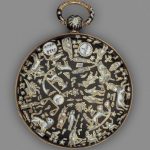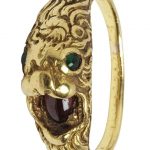Ruby. The second hardest gems after diamonds, rubies have always been prized for their color. During the Middle Ages, deep-red rubies were imported into Europe from India, Sri Lanka, and Burma. From Afghanistan, merchants brought paler, pinkish stones known as balas, or spinel rubies, which were not as prized because of their less brilliant coloration. Rubies were deemed chief among stones, and those as bright and lustrous as pomegranate flesh were especially celebrated. Their intense red color has often been associated with passion, protection, and love.
Late medieval and Renaissance lapidaries, or collections of writings on precious stones, not only described the physical properties of gems, but also ascribed to them magical powers and intrinsic virtues. Often relying on Roman and Greek sources and more recent texts, these lapidaries proclaimed that the ruby could promote health, dispel bad thoughts, serve as a defense against poison, bring concord between people, and even serve as a guard against lust. In some cases, it was thought that the stone would darken to transmit important information, like the presence of danger, to its wearer. The ruby was a rare and powerful stone, and it comes as no surprise that it appears in extraordinary jewelry. Reference: The Metropolitan Museum.
Rubies are the birthstone of July although from the 15th century up to the early 20th century it was considered the birthstone of December.
Watch ca. 1826–31 Watchmaker: Firm of Bautte et Moynier This pocket watch belongs to a category of upscale souvenir watches. It features Egyptian zodiac symbols taken from a Ptolemaic sandstone bas-relief that was brought to France in 1821 from the Temple of Hathor in Dendera, Egypt
Case: enameled gold; Movement: gilded brass and steel with ruby endstones
Reference: The Metropolitan Museum
A rare Mughal gem-set gold spoon, India, 17th-18th century the shallow bowl delicately inlaid on the reverse with a lotus rosette comprised of radiating foil-backed diamond petals and rubies, the faceted tapering shaft inlaid with emeralds and bands of ruby quatrefoils within an engraved and chiselled gold framework, gold lotus bud terminal 14.5cm.
This spoon is comparable to the magnificent early-seventeenth-century spoon in the Victoria and Albert Museum (VAM 173-1910). The form of the V&A spoon, like our example, is derived from a European prototype and both are decorated, except for the inside of the bowl, with an interlace of rubies, emeralds and diamonds. The exact function of these spoons is unknown but Annemarie Schimmel has suggested that they might have been used to distribute sweets over which the Fatiha had been recited (Welch 1985, p.200, no.128).
During the seventeenth century precious objects were often set with gemstones in the manner seen here, as recorded by the traveller Jean de Thevenot who describes gold and gem inlaying at Agra (see India in the Seventeenth Century, Vol II, ‘The Voyages of Thevenot and Careri’, ed. J.P. Guha, New Delhi 1979) .The kundan technique employed for the settings is unique to India. Using hyper-purified gold (kundan), the inlayer (zar-nishan) refines the soft metal into strips of malleable foil which at room temperature have a ‘tacky’ or adhesive quality. Once cut and folded, the craftsman can apply the ductile gold as he chooses without any need for solder or glue. In spite of the practical advantages of this technique, it was only ever used in the Subcontinent, though widely imitated elsewhere (Keene 2001, pp.18 and 30).
The distinctive radiating lotus design on the back of the spoon relates closely to an architectural decorative device favoured during the reign of the emperor Shah Jahan. Interlocking panels radiating from a central rosette can be seen on the painted plaster ceiling of the Badshahi mosque in Lahore (1674 AD). A pair of late-seventeenth-century marble lotus-form stepping-stones from the collection of Howard Hodgkin (illustrated in R. Skelton (ed.), The Indian Heritage, London, 1982, no.12), display the same radiating petal design. The radiating lotus is an ancient symbol whose origins lie in the lotus roundels of early Buddhist monuments, such as the mahastupa at Amaravati, 2nd century AD.
Sold for 409,250 GBP at Sotheby’s in 2011
Gold ring, cast; the bezel in the form of a roaring lion’s head, the eyes set with emeralds and the tongue formed by an oval ruby. The shoulders decorated with the lion’s mane.
The finely detailed cast decoration on this ring is enhanced by the use of precious gemstones. The imagery of the lion and its pelt is an expression of the interest in the classical past that was so evident in the 16th century.
Reference: © Victoria and Albert Museum
Amulet-ring; gold; slender flat hoop with nielloed inscription; raised oval bezel containing ruby. 14th Century
Reference: © The Trustees of the British Museum
AN UNUSUAL RUBY, COLOURED DIAMOND AND DIAMOND ‘CHIMAERA’ BANGLE, BY CARTIER Designed as a crossover hinged bangle with two pavé-set ruby chimaeras, to the brilliant-cut diamond eyes and baguette-cut diamond comb, enhanced by yellow diamond jaws, mounted in 18k gold and platinum, circa 1970, 5.8 cm inner diametre, with French assay mark for gold, in red leather Cartier case Signed and with maker’s mark for Cartier Paris, No. 4793
Sold for HKD 1,327,500 at Christie’s in 2008
Gold, Diamond and Ruby Knight Watch Fob Bloodstone seal, with glazed compartment, ap. 23.7 dwts.
Sold for $2,500 (includes buyer’s premium) at Doyle in 2020








